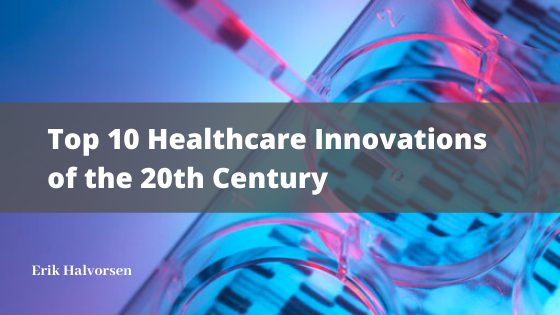Undoubtedly, the 20th Century was an era of the greatest innovations and advances in medicine as the average life expectancy increased from 50 years old in 1900 to a current life expectancy of ~77 in the US. It should not be too much of a surprise that most of our medical advances have come in our more recent history. After all, Louis Pasteur did not publish his “Germ Theory” which stated that germs or microbes caused disease and illness until 1861. Prior to that common belief was people got sick due to miasma or “bad air”. For those of us who travel frequently on planes—we still think there is something to the whole miasma theory as well but now we know that bacteria and viruses are the likely culprits.
While I have been extremely fortunate to witness a number of innovations in healthcare through my work with various medical device and drug development companies most of these pivotal discoveries came before my time. Here are just a few of the most impactful medical innovations of the 20th Century, and why they still matter today.
- Discovery of the Structure of DNA
While the initial discovery of DNA is credited to Johann Miescher in the 1860s, it wasn’t until work at a Cambridge University laboratory in 1953, led researchers Francis Crick and James Watson to make a discovery that would change the world. The scientists had discovered the 3-D structure of DNA, and our understanding of genetics as a blueprint for who we are—what makes us unique, what makes us susceptible or what makes us strong has new insights being unlocked daily.
- Discovery of Penicillin
Through one of the most serendipitous medical discoveries of all time, Alexander Fleming is credited with the discovery of penicillin and the entire class of drugs known as antibiotics. While studying staphylococcus bacteria, he left his laboratory window open which allowed for mold to contaminate his petri dish. The next morning he noticed the bacteria could not grow near the mold and he hypothesized that the mold must be secreting a substance. It was 1928 and mass production of penicillin did not start until the 1940s—just in time for World War II. Today there are over 100 antibiotics with ~250 million prescriptions per year credited with saving millions of lives since Fleming’s discovery.
- Chemotherapy
Chemotherapy, like much of the early work and discoveries on therapeutics to treat disease, evolved from other industries. In this case, two researchers from Yale, Alfred Gilman Sr. and Louis Goodman, began investigating the use of mustard gas (a weapon from WWII) to kill cancer cells. Often considered the fathers of pharmacology, they published the quintessential text book on the topic, The Pharmacologic Basis of Therapeutics (required reading when I was getting my PhD). But it wasn’t until a Harvard pathologist, Sidney Farber, who developed folate analogs as a chemotherapeutic agent and achieved the first documented full remission in a pediatric patient with acute lymphoblastic leukemia in 1948 that the field took off. Today, there are more than 100 approved chemotherapeutic agents with more than double that in clinical development, which is good news. Sadly, cancer is still the 2nd leading killer in the US with nearly 2 million new cases expected in 2019.
- Treatment of Tuberculosis
In the 19th Century, tuberculosis was widespread, and deaths from the disease were extremely common. Great thinkers like the poet John Keats and composer Frederic Chopin were cut down in the prime of their careers due to tuberculosis, and the condition killed so many artists that it was once known as the “romantic disease” but later went by the less flattering synonym “consumption”. The disease caused by the bacterium, Mycobacterium tuberculosis, was discovered by Robert Koch in 1882, which resulted in severe respiratory inflammation, coughing, and eventually internal bleeding and death. Scientists Selman Waksman, Elizabeth Bugie, and Albert Schatz were instrumental in developing one of the first effective treatments for tuberculosis through their work on streptomycin. Unfortunately, the emergence of antibiotic resistant strains of tuberculosis have seen a resurgence of this disease in many areas of the world with ~10 million new cases reported in 2017. Subsequent development of new antibiotics and vaccines hold the promise to keep tuberculosis at bay.
- Polio Vaccine
Before Jonas Salk invented the polio vaccine in the 1950s, millions of children and adults who were stricken with the disease suffered from paralysis that could lead to suffocation and death in the most severe cases. Survivors were often left with varying degrees of muscle dysfunction or paralysis. Prior to the development of the vaccine, another innovation, the “Iron Lung” was developed by Harvard researcher Phillip Drinker and first used on patients at Boston Children’s Hospital. The Iron Lung reduced the suffering and saved the lives of numerous polio patients and became the precursor of modern ventilation technology commonly used in hospitals around the world. Thanks to the work of Jonas Salk, polio has been nearly wiped out of existence with no new cases reported in the US since 1979.
- Development of Insulin Therapy
The description of what is now known as “diabetes” can be found in literature references dating back to the 15th century noting the urine of patients with the affliction had a sweet smell and taste. It wasn’t until the discovery of the role of the hormone insulin and the subsequent development of insulin therapy that revolutionized the way that doctors treat diabetes. This pancreatic extract was first used in 1944 to save 14-year old Leonard Thompson’s life. Prior to insulin therapy, diabetes was controlled solely by diet or not at all. Today, we know that there can be a number of causes and forms of diabetes and that combinations of monitoring, diet, exercise and insulin therapy can enable people to live long and active lives.
- Treatment of Tropical Diseases
Tropical diseases are those diseases that are most prevalent in regions near the equator where the warm climates and significant rainfall create ideal conditions for breeding of insects that carry disease and transmit it to animals and humans. Many of these diseases became of interest to the western world originally due to colonization of these areas and as more global travel occurred and increased chance of transmission arose. More recently we have seen these so-called tropical diseases popping up in more temperate climates around the world, including the U.S. with the mosquito transmitted Zika virus and Dengue virus. According to the CDC, in 2017 there were still an estimated 219,000,000 cases of malaria and 435,000 deaths. While the number of Ebola cases annually is far less than malaria globally, the fear of its destructiveness and speed in which it can spread has spurred significant efforts to generate a vaccine. Ironically, some of the biggest advances in the treatment (or prevention) of tropical diseases has been by improving access to clean water, improving sanitary living conditions, education and access to bed nets. Significant development of antibiotics, anti-parasitics and new vaccines have also dramatically reduced the incidence of many of these diseases.
- Modern Anesthetics
Use of anesthetics in medical procedures can be found throughout ancient history by the Egyptians, Chinese, Greeks and many other cultures. Commonly known sources included the opium poppy and, of course, alcohol. While additional anesthetic agents were discovered and used in the 18th and 19th Centuries, including nitrous oxide (still used widely today), it was not until the 1900s that general anesthesia became more widely used, and more effective, as doctors learned techniques around titration and ventilation. This included some of the first intravenously delivered anesthesia that had the notable advantage of not being flammable—an unfortunate side effect and cause of many early operating room mishaps with inhalational anesthetics. Today, there are many different anesthesia options for doctors to choose from but many commonly used today were discovered a century or more ago. Interestingly, the exact mechanism of action as to why these drugs work and how they create this lack of sensation and consciousness is still largely unknown.
- Organ Transplantation
While there are certainly references of organ transplantation, or at least attempts, earlier than the 20th Century, it is commonly accepted that modern transplantation did not truly begin until the mid-1900s. In the 1950s, the first successful kidney transplants took place albeit with varying degrees of time and success before rejection or kidney failure. The main reason for these failures was due in part to insufficient surgical technique and expertise but also graft-versus-host disease or when the recipients immune system would attack the donated organ because it recognized it as “foreign” like when it fights off an infection. Increasing understanding of the immune system, tissue matching donors and the development of immuno-suppressive drugs helped reduce rejection of donor tissue and allowed for surgical pioneers to transplant bone marrow, liver (1967), heart (1968), heart and lung (1981) and double lung (1986). Other more recent and press-generating procedures included full facial and hand transplants. One thing is certain, advances in transplantation offer hope for many where that is the only option. However, currently, there are far too few donor organs available for these patients.
The Human Genome Project (HGP) began in 1990 and was completed in 2003. It is often compared to another significant scientific accomplishment—man landing on the moon. The goal was, using a team of international researchers, to decode the human genome and understand our blueprint—the genes that make us who we are but also how those genes may be involved in diseases such as cancer. When the results were published, then director of the NHGRI Dr. Francis Collins wrote that the genome was like a book: “It’s a history book – a narrative of the journey of our species through time. It’s a shop manual, with an incredibly detailed blueprint for building every human cell. And it’s a transformative textbook of medicine, with insights that will give health care providers immense new powers to treat, prevent and cure disease.”
Today, our ever increasing understanding of the genome is changing the way that doctors look at inherited diseases and think about the interplay between our genes and what we are exposed to over time. What initially took 1,800 researchers,13 years and $2.7billion to sequence ONE genome, now can be completed in a matter of hours for less than $1500. The increased speed and decreased cost has made sequencing technology more accessible and opened up the field of personalized medicine—treatments tailored to the specific needs of the individual rather than a population based on their unique genetic makeup.
Agree with what you see? Are there others you think I missed that should be on the list? Please leave comments below. The 20th Century was an amazing time for medical discoveries that have greatly increased life expectancy. Almost two decades into the 21st Century, what will end up being the most impactful discoveries to improve the health and wellness of mankind?
Erik Halvorsen is the Chief Business & Strategy Officer at FAR Biotech. As a result of his industry experience, Erik is an often sought-after public speaker, and he has served as an advisor to various hospitals and start-ups. He is constantly looking for new ways to improve patients’ lives while changing the broader healthcare industry for the better. He has been referred to as a “translator,” in that he has the ability to speak science with businesspeople and speak business with science people.

